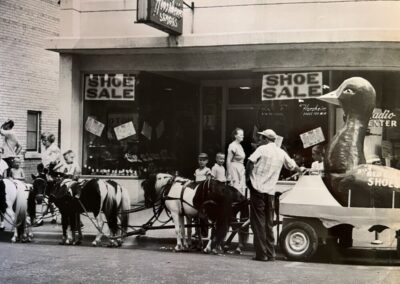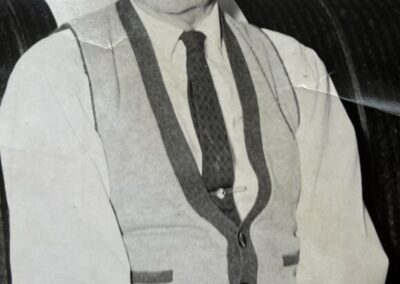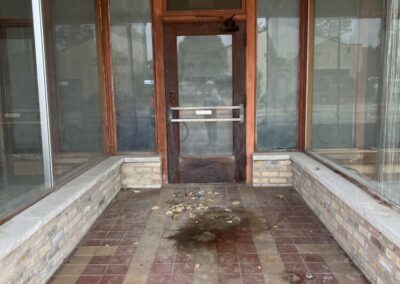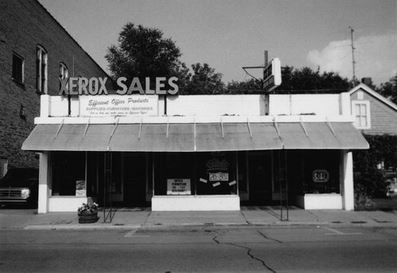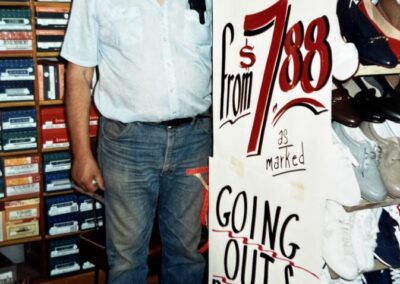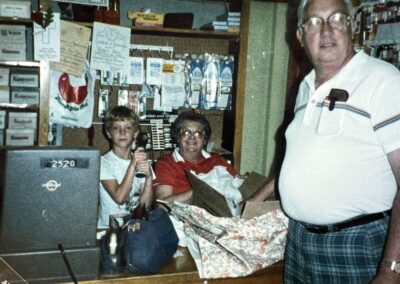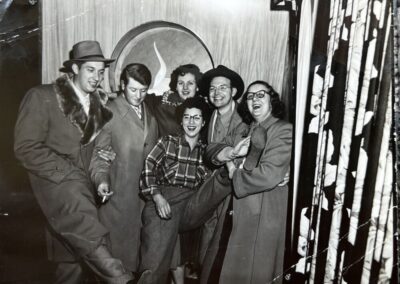Location
Photo Gallery
July 1989 – Going out of business sale at Reinholz Shoes. Oscar and Shirley Reinholz with John Miesbauer.
A Brief History
Reinholz Building
226 S. Main St.
Shawano, Wiscoinsin
Built in 1946, this building was the home of Rienholz Shoe Store for years. After closing as a shoe store, the building was used by other businesses. When Stubborn Brothers Brewery renovated the Nagle Building next door for their business, they bought the Reinholz Building, remodeling the interior into the kitchen for the restaurant.
Herman Reinholz was a cobbler that began as a shoe retailer in Gillett, Wisconsin in 1913. By 1938 he had moved his business to the former Karth Furniture Store Building at 208 S. Main Street, and in 1946 he moved into his new building at 224-226 S. Main Street. The Reinholz Building was the first constructed in the district after World War II, and Reinholz had his name tiled into the floor in front of his store. Although the pre-war tradition, in many cases, had been to build a second story to allow for the shopkeeper’s home, Reinholz had no need for living space. By 1941 he had purchased the house at 228 S. Main Street, immediately south of his new store building. Herman Reinholz ran that portion of the business in the back section of the store until his retirement. Oscar Reinholz, Herman’s son, ran the shoe store until he sold it upon his retirement to Judith Reinholz and her husband Joseph Miesbauer.
Selling shoes proved to be a successful and stable specialty business for several retailers on Main Street. Including Reinholz, John and Joseph Lieg and sons of a prominent Shawano retail family, opened their shoe store 1921 in the former Rohloff building at 126 S. Main St., which they replaced with a new building in 1933. Schauder Shoes in the Kuckuk and Pulcifer Building on Main Street was another prominent shoe business for decades.
From the 1999 National Register of Historic Places Registration application:
This one-story concrete and stucco building, at the southernmost edge of the district, was the first new construction in the district following World War II, and is highly intact. The building has two storefronts with only a vestige of a facade above the storefront windows; this upper portion is unadorned except for non-historic signage. This space is defined on either side by an extension of the storefront piers, which terminate at the upper edge of the facade, and is divided from the storefront by a flat, unadorned, projecting shelf, which extends no more than one foot beyond the piers. A non historic, fixed, shed-style, corrugated metal awning projects over the sidewalk in front of the building, and is supported near the street by non-historic wrought-iron supports.
The storefront’s display area consists of plate glass windows in narrow aluminum frames resting upon stuccoed bulkheads. The display area has four segments of display windows at the sidewalk level, one at either side and a pair in the center. These flank the two entries, which are deeply inset from the sidewalk. Each door has a wood frame and large plate glass window, which appear to be original to the building, and is surmounted by a single-pane, wood-frame transom light. The doors and transoms are framed by stuccoed members, which set them apart from the two narrow display windows that flank each entry. These display windows are joined to those at the sidewalk level by similar display windows set perpendicularly to their counterparts. The floors of the inset entry ways surrounded by these display windows are inlaid with red and maize tile; the northernmost of the two entry ways also features the name of the building’s original owner in one-inch red and white tiles inset into the larger pattern.

